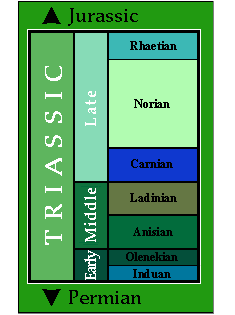The Triassic Period
248 to 206 Million Years Ago
In many ways, the Triassic was a time of transition. It was at this time
that the world-continent of Pangaea existed, altering global
climate and ocean circulation. The Triassic also follows the largest
extinction event in the history of life, and so is a time when the
survivors of that event spread and recolonized.
The organisms of the Triassic can be considered to belong to one of
three groups: holdovers from the Permo-Triassic extinction, new
groups which flourished briefly, and new groups which went on to
dominate the Mesozoic world. The holdovers included
the lycophytes,
glossopterids,
and dicynodonts. While those that went on to dominate
the Mesozoic world include modern conifers, cycadeoids, and the
dinosaurs.
Click on the buttons below to learn more about the Triassic.



 |
Subdivisions of the
Triassic:
The chart at left shows the major subdivisions of the Triassic Period.
Click to go forward to the Jurassic, or back to the end of the Paleozoic
Era, the Permian Period.
The Triassic Period is part of the
Mesozoic Era.
|
For more information, see Charles Messing's course
notes on life in the Early Mesozoic.
Find out more about the Triassic paleontology and geology of North America at the Paleontology Portal.









